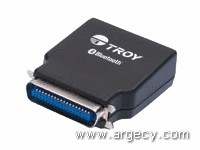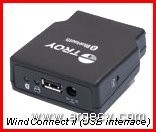WindConnect


| WNDCTII-P01 WindConnect II Parallel - FCC domain - US power supply | WNDCTII-U01 WindConnect II USB - US power supply | WNDCTII-U03 WindConnect II USB - European power supply |
Print Any Time, Anywhere!
The WindConnect II allows users with Bluetooth enabled laptops, PDAs, cell phones or cameras to send documents to a printer without connecting a cable to their device. USB and Parallel port versions of the WindConnect II are available. The USB version plugs into the USB port of the printer with the provided USB cable and supports a wide range of printers with 1.1 or 2.0 USB ports. The WindConnect II with a parallel port plugs directly into parallel port of the printer. WindConnect II supports the Service Discovery Protocol (SDP), allowing the printer to be discovered by any sending device that supports the SDP protocol. It can operate in any of the following modes:
Serial Port Profile (SPP)
In this mode the data is passed unmodified to the printer. That is, the sending device and WindConnect II look to the software as though they are communicating via a hardwired RS-232 connection. Therefore, WindConnect II can be used with any application that supports printing over the serial port (although the actual physical connection between WindConnect II and the printer is USB or parallel, the sending device thinks it is communicating to a serial device). With Windows systems, this means that standard printer drivers like the HP
LaserJet 5 driver can be used and no special software needs to be installed.
Hardcopy Cable Replacement Mode (HCRP)
HCRP is another standard for printing over a Bluetooth wireless communications link. It provides the same functionality as the SPP, but gives much better status and control capabilities. WindConnect II implements all of the mandatory and optional HCRP features (including support for the Microsoft Windows XP operating system implementation) with the exception of the scanner support.
Object Push Printing Mode (OPP)
This mode allows cellular telephones, PDAs and other devices that support the Bluetooth OPP to send vObjects wirelessly to a printer. WindConnect II translates the vObject into ASCII data so that it can be printed out on most popular types of printers. TROY's OPP also allows printing JPEG images to most HP and other PCL compatible printers.
Basic Printing Profile (BPP)
The BPP is designed for limited resource devices like cell phones and PDAs. These devices do not typically have adequate memory to store multiple drivers. The BPP addresses this problem by eliminating the need to load different drivers for different printers. The BPP defines a mandatory minimum image and document format,
which is a standard way of handling both text and graphics. This common format allows any Bluetooth sending device to get legible output on any Bluetooth printer. The BPP in the WindConnect II currently supports printing to most HP and other PCL compatible printers.
Basic Imaging Profile (BIP)
BIP enables Bluetooth devices such as cameras and camera-enabled PDAs and cell phones to negotiate the size and encoding of imaging data to be exchanged. To ensure interoperability, BIP requires that all Bluetooth imaging devices be capable of receiving JPEG thumbnail images and/or providing JPEG thumbnail versions of their stored images. The BIP in the WindConnect II currently supports printing to most HP and other PCL compatible printers.
Compatible and Easy to Use
WindConnect II is compatible with a Bluetooth sending device that can print using the abovementioned profiles. The following is a sample list of devices that WindConnect II has been successfully tested with:
Most major laptop PCs with either built-in or add-on Bluetooth capabilities including Sony Vaio BT C1MGP with Bluespace, Sony Vaio FX Series, Compaq EVO with built-in Bluetooth Multiport module, Compaq/HP Presario, IBM, Toshiba, Dell, and HP Pavillion / Omnibook
Most popular Bluetooth PC cards including 3Com, Belkin, IBM PC Card II, TDK PC Card and Xircom
Most popular Bluetooth USB adapters including ActionTec USB, Anycom USB, TDK USB Adapter, IBM Ultraport USB, 3Com USB, Belkin USB, and D-Link DBT-120 USB. WindConnect II has also been tested with Microsoft Wireless USB Adapter using the Microsoft Bluetooth stack.
Palm PDAs with built-in Bluetooth capabilities, Palm Bluetooth SDIO cards or third-party Bluetooth adapters including Palm m130/m515 with Palm Bluetooth SD Card, Palm Tungsten T w/ built-in Bluetooth
Pocket PC PDAs with built-in Bluetooth capabilities, Bluetooth Sleeve or Bluetooth SDIO and Compact Flash cards including IPAQ 3670/3970/5450, Anycom CF-2001 Card, Belkin CF Card, Socket CF Card, Socket SDIO and Toshiba e740
Bluetooth enabled mobile phones including Nokia Series 60 and Sony Ericsson T610, T616, and Z600 camera phones
Bluetooth enabled digital cameras such as Sony DSC-FX77
Ordering Information
WNDCTII-U01 WindConnect II USB - US power supply
WNDCTII-U02 WindConnect II USB - Universal power supply
WNDCTII-U03 WindConnect II USB - European power supply
WNDCTII-P01 WindConnect II Parallel - FCC domain - US power supply
WNDCTII-P02 WindConnect II Parallel - FCC domain - Universal power supply
WNDCTII-P03 WindConnect II Parallel - ETSI domain - European power supply
Speed
Up to 720Kbps full duplex
Dimensions
USB 7.6 L x 6.6 W x 2.6 H cm (3.0 x 2.6 x 1.0 inches)
Parallel 8.3 L x 6.6 W x 2.6 H cm (3.3 x 2.6 x 1.0 inches)
Weight
USB 2.3 oz. (65 g) without power supply
Parallel 2.6 oz. (75 g) without power supply
DC Power 400 mA @ +5VDC
AC Power 115VAC 60Hz external adapter (U.S.); 100 to 240VAC 50/60Hz external adapter (international)
Connectivity
1.1 or 2.0 (USB version)
IEEE P1284 bidirectional Centronics-compatible (parallel version)
Bluetooth Radio Class 2 radio (10 meter operating range)
Bluetooth Profiles
Serial Port Profile, Hardcopy Cable Replacement Profile, Object Push Profile, Service Discovery Profile, Basic
Printing Profile, Basic Imaging Profile
Operating Systems
Any operating system that provides printing functionality using one of the supported Bluetooth profiles
Temperature:
Operating: 0o to 40o C
Storage : -20o to 60o C
Altitude:
Operating: 3.1 km
Storage: 9.1km
Relative Humidity:
Operating: 15% to 80% non-condensing (40 to 60% recommended)
Storage: 10% to 90%

